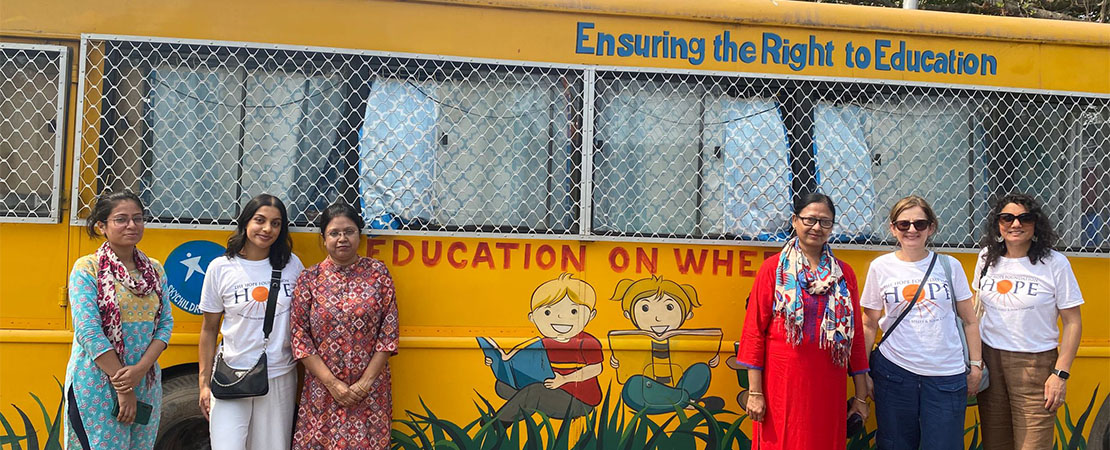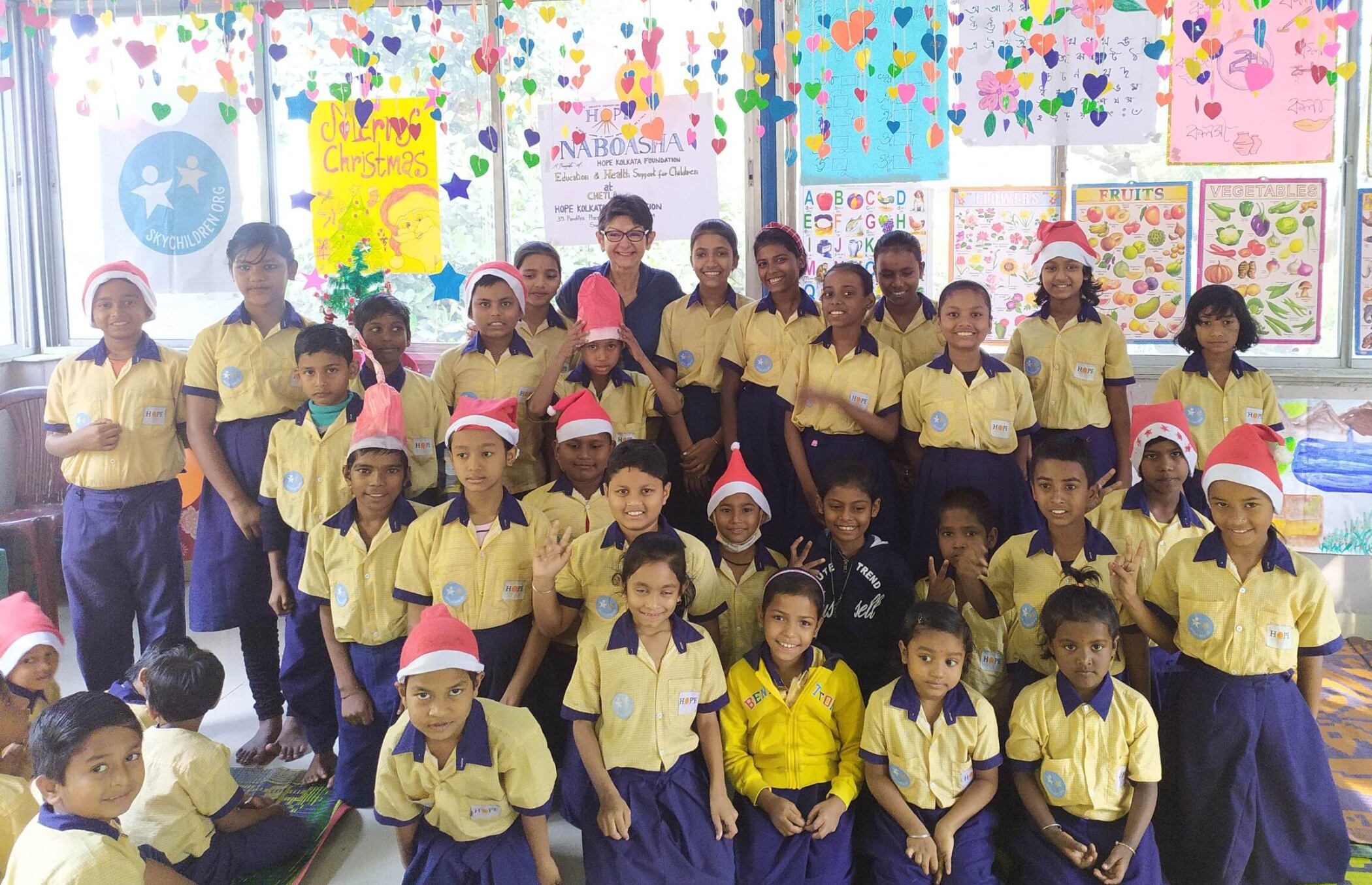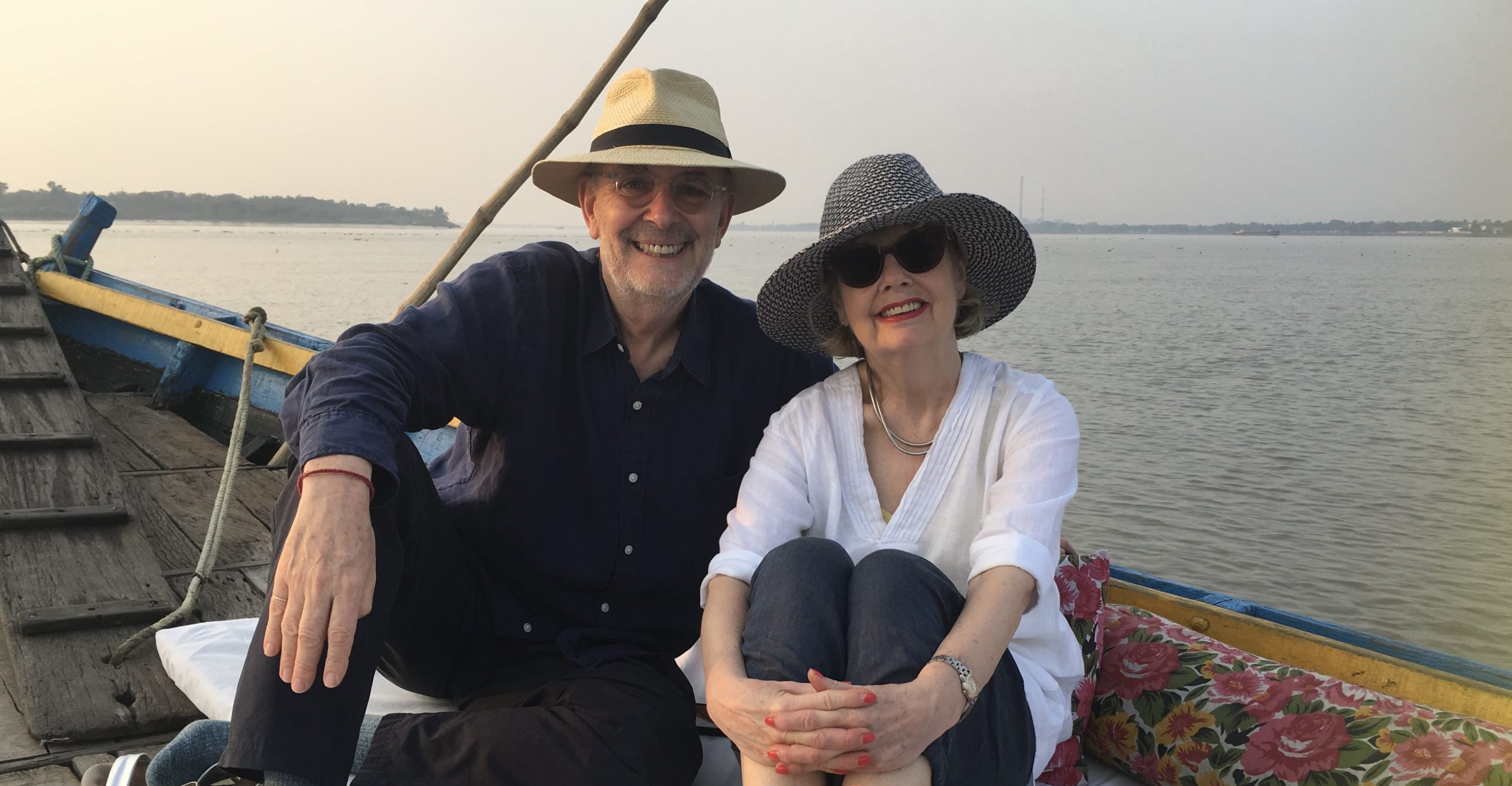|
Getting your Trinity Audio player ready...
|
Award-winning broadcaster and HOPE Ambassador Andrea Catherwood first visited HOPE’s programmes in Kolkata in 2009 and had the chance to meet the two toddlers she was sponsoring. Below Andrea shares an extract of an article she wrote at the time about the impact that first visit had on her, the moving stories of the children she met, and how the connection with HOPE has extended through her family.
(Image above shows Andrea interviewing Indian politician Shashi Tharoor at a HOPE event in 2023)
When you are on TV, understandably, lots of charities ask if you can help raise publicity and funds. A friend who was very passionate about HOPE encouraged me to take a close look the work it did. I was a foreign correspondent and had seen first-hand the transformative work that charities can do in places like Afghanistan, Sierra Leone and Gaza, but I’d also seen how often resources were wasted. I first encountered HOPE’s work directly in 2009 in Kolkata and I was so impressed with the grassroots organisation, how embedded it was in the community, the deep understanding of the needs of the children and the relentless commitment of the HOPE team. I’ve been an Ambassador of the Hope Foundation ever since, and I’ve been so proud to have witnessed how, through its unrelenting dedication, it has used your contributions to reshape countless lives.
This is an extract from an article I wrote for the Mail on Sunday Review on my return from that first Kolkata trip. It probably encapsulates how HOPE’s work impacted me better than anything I could write today:
Extract from 2009 article
“Feeling vaguely uncomfortable I flick though the pages of the blue plastic folder, scrubbed faces stare back at me. How do I select the kids our family is going to sponsor? Despite being neatly dressed and sitting astride the same red plastic trike for the picture, they all come from one of the worst slums in Kolkata.
I chose two boys, Jeetu*, because the scant details accompanying each photo reveal his mother didn’t know his date of birth, which seems intrinsically sad. And Nabhas*, because his serious expression is just like one of my son’s (a rubbish reason, I know, but I couldn’t think of another).
That was six months ago. Since then, their photos have hung on our notice board, slowly buried under kids’ party invitations, spellings to be learned and dentists’ reminders. Until last week, when I dug them out ahead of my own trip to Kolkata, where
I’d get to find out the stories behind their faces.
What I found in the slums of Kolkata were some of the most disturbing and heart-breaking stories I’d ever witnessed, heightened perhaps because this is not an international crisis. These aren’t children experiencing a hiatus in their lives through war or disaster, this just is their life.
I’m often asked if my years as a foreign correspondent inured me to suffering, in fact I think the reverse is true, the more pain I see the

harder it becomes to accept. I’ve learned the currency of grief is not devalued by overuse.
The toddlers I’m sponsoring are part of a new intake in HOPE’s’s crèche in Panditya slum. These children are amongst the most vulnerable in an area where everyone lives in abject poverty.
The children taken into the crèche are malnourished and left alone each day, while their mothers try to earn money. Left to roam the streets or beg, hungry and dirty, they are easy prey for child traffickers. Forty-eight thousand children go missing in India each year.
Geeta, who runs the crèche, points out a little girl to me who was found tied to railings near a main road; her own mother had bound her up to protect her while she was gone. While another who had been left with a local woman, while her mother went to work, had been sold to traffickers. HOPE had managed to trace the child.
I search the little faces for my boys. I recognise Nabhas straight away. He comes to me easily but without any smiles. He looks exhausted. He wraps his arms and legs round me; he’s light as a feather. He doses passively while Geeta tells me the story of his little life.
Nabhas’ father was a drunk who beat his wife viciously in front of his sons. Nahbas and his seven-year-old brother used to go with their mum to the construction sites where she gets casual work. His brother was already being recruited into child labour on the sites where accidents involving the children from the slum are rife.
Imagine leaving your toddler alone on a building site. Imagine having no other option. Life expectancy in the slums is around 40 and TB is rampant so grandparents who might help out are long gone.
The other boy I’m sponsoring, Jeetu, is too traumatised to be held by me or any of the crèche workers. He clings to his older sister, Sita*, and shows an animal like fear I don’t think I ever seen before in a child. Staff think he could be four, but he’s tiny and very malnourished. His six-year-old sister had been caring for him on the streets while his single mother worked as a maid; she cleans three homes each day. In total she earns less than £10 each month. His stick thin sister’s face looks grown-up.
I can see why when I visit their home. Slum life is brutal. The boys both live in an area called Dover Terrace, the name an incongruous hangover from Kolkata’s colonial past. Water from a pump, one lavatory for 20 families, no privacy, no respite from the heat, the filth and the stench.
Nabhas’ mother, whom I know is regularly beaten, looks nervous and tired. She shows me the one cramped room her family shares with two other adults. A thin mattress on a board is balanced on bricks under it sit some pots and a


kerosene stove. A few clothes strung on a line by the doorway provide a curtain. There appear to be no other possessions.
Jeetu’s slum is much worse; it isn’t a room but a tiny shack maybe 3 feet wide. He’s lying asleep on the floor as his sister watches us warily. Two families live here, a man and woman, who is not Jeetu’s mum, are curled up in the darkness.
It’s easy to be overwhelmed by the scale of the suffering, but HOPE firmly believes education can break the cycle of grinding poverty. Through the sponsorship programme they give a long-term commitment to children like Jeetu and Nabhas, and the first hurdle is to get them into school. To do this, HOPE applies for the birth certificates or ID card that few children from the slums have, but which they need to attend. The £17 [now £20] a month sponsorship pays for the extras of the supposedly free education, like uniforms and books, which routinely prevent the poorest from going to school.
It also supports HOPE’s after school coaching centres [called Naboasha centres] where kids of parents who are not literate get help with homework from volunteers and crucially, one hot meal a day. HOPE works with the families to keep the kids at school, and where children are already breadwinners, HOPE trains the mothers and helps them find work instead. When children have been abandoned, orphaned or a mother is totally unable to care, it takes the children into its residential childcare centres.
The programme is strikingly successful. In the slums where HOPE works, like Panditya, 90% of children are now in school. In slums with no support that figure is neatly reversed. Less than 10% of kids get an education.
I leave the slums feeling mildly optimistic about the boys’ future. Nabhas is wrapped in his mother’s arms, as she waves goodbye from their doorway, clutching the incongruously clean teddy I’d brought from London, an open sewer running by her feet. Jeetu is sleeping on the floor of the cramped slum where he and eight others scramble to survive, the useless teddy I had given him propped beside him in the dirt. He can’t eat it or wear it, he’s no idea what to do with a toy. My translator worries his mother will sell it for food. I would if I were her.”
15 years on...
That was fifteen years ago. Jeetu and his sister disappeared a few years later, I think of them often. Despite HOPE’s best efforts we never discovered what happened to them, but HOPE’s intervention eased their lives a little during those few traumatic years. We sponsored Nabhas for many years, his father left, then returned having stopped drinking and found steady work. A good news story, Nabhas stayed in school and they no longer needed our support.
I’ve visited Kolkata with my own growing family (and learned to bring more appropriate gifts, colouring pencils, books, footballs and cricket bats). I made a BBC Radio 4 programme in Kolkata about HOPE’s work. The most amazing group of young people brought up in HOPE’s residential childcare

centres, led by Geeta [HOPE’s late director], who I was proud to call a friend, came to stay with us in London when they represented North India in the Street Children’s Cricket World Cup. This included one incredible young woman who was abandoned as a baby on a HOPE doorstep, who next year will take up a place at a British university. Devastatingly, Geeta, the beating heart of the Kolkata operation, died of complications when Covid wreaked havoc on one of the world’s most vulnerable populations.
I’ve witnessed children born on the street into almost unimaginable deprivation, who’s young lives were blighted by cruelty and suffering, emerge as articulate, kind and ambitious young people. This year, one of my own sons lived in Kolkata and volunteered with HOPE, and we also sponsor a new generation of children. Knowing that you are supporting these families to climb out of the crushing cycle of extreme poverty and having such a direct impact on young lives is something you won’t regret. In fact it may prove for you, as it has for me, to be something that enriches your own and your family’s life.
*Names changed
Sponsorship makes a real, lasting impact on the life of disadvantaged children in Kolkata. Find out more about HOPE’s child sponsorship programme.




